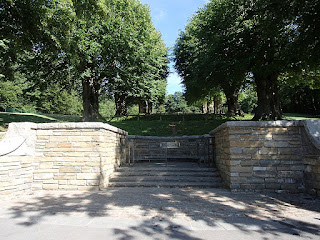Time for walkies at Canal Foot for the Duddon History Group, the entrance to what was once the shortest canal in the country which today is a magnet for anglers, runners and strollers. The ship on the sign gives a clue to the reason for the canal as these came in at high tide from Morecambe Bay but there were also shipbuilders here as well. The notorious shifting sands and channels of Morecambe Bay added a bit of jeopardy to the changing locations of piers. The canal had a short operational life and the coming of the Furness Railway sounded its death knell. Canal Foot is now an ideal place to see the long railway viaduct (part of which can be seen in the background of the photo above) and the trains crossing, watch the bird life and enjoy the view,

We however were in search of past industries of which little remains but limestone quarries and lime kilns. The limestone is used in the iron making process and there were quite a few plants here at one time with also an iron ore mine but this view is what was the track-bed of the industrial rail link coming into the area and a rather fine limestone wall.
When I downloaded my photos I wondered why I had taken a picture of a field. Sheep in fields I am rather fond of but they are way in the distance then it was pointed out that banking loop to the right is also the old rail track. In the distance can be see Hoad Hill
and the monument. One can never get lost in Ulverston with this landmark and for generations of people a marker from a long journey that "we are nearly home". After looking down the watery depths of the old iron ore mine we looped back to the canal
Low autumn light can make taking photographs tricky but it also lights up the colours of the few remaining leaves reluctant to let go.
After lunch at Canal Foot we journeyed half a mile down the road to the quiet hamlet of Sandhall with a handily placed postbox. In the 19th Century it was a hive of industry which included quarry, brick, and wire works and just round the corner
Carter Pool where the last ship to be built in Ulverston was constructed. From the size of it today it seems rather incredible. Nothing on the surface remains of these industries and today this is a watery flat land and we watched hundreds of geese flying in formation in the sky, dividing and and then combining making shapes as they wheeled across the sky. Did I say nothing remains of the old industry here? Well there are two slag banks where now bee orchids grow and
a rather beautiful chimney that was once part of the wire works which operated from around 1882 to about 1919 and was left as a navigation aid for vessels berthing at Ainslie Pier, Hammerside.
The white brick banding is actually more yellow but digital doesn't pick it out too well. It looks to be in rather good condition.
I got rather excited about this chimney so clicked happily away as we passed it. Our guide for the day was Rod McKeever whose book The Industrial Archaeology of South Ulverston no doubt will guide us for another visit to the area.
Further and more informed information of Ulverston Canal and South Ulverston can be found on the Cumbrian Industrial History
site





